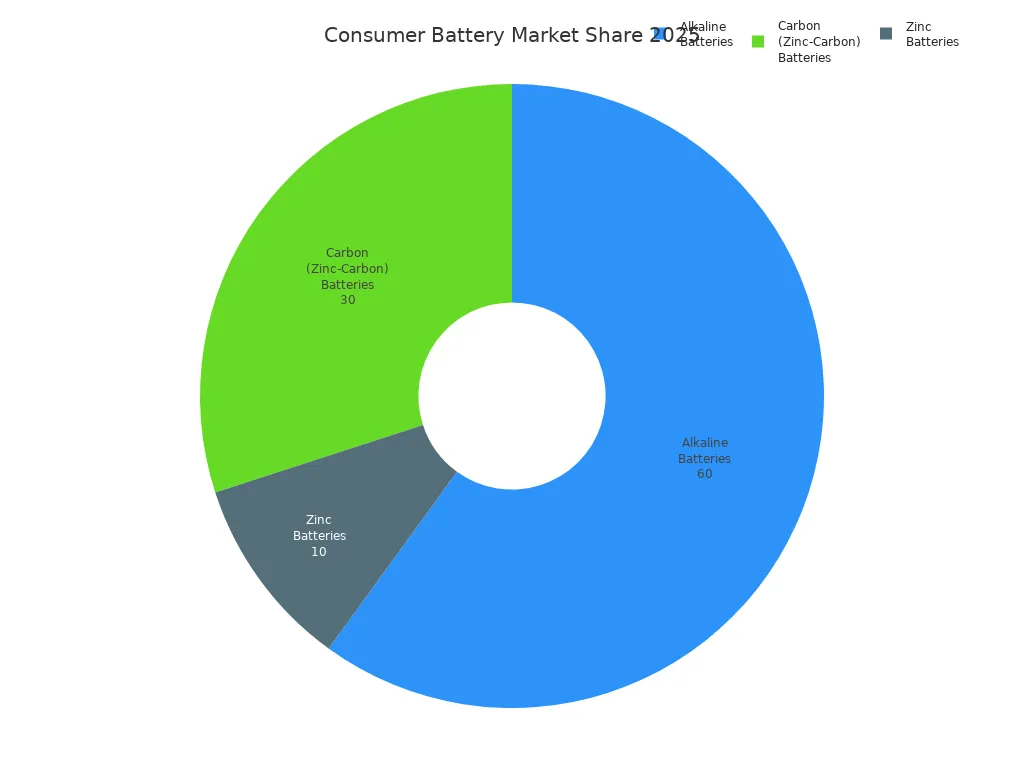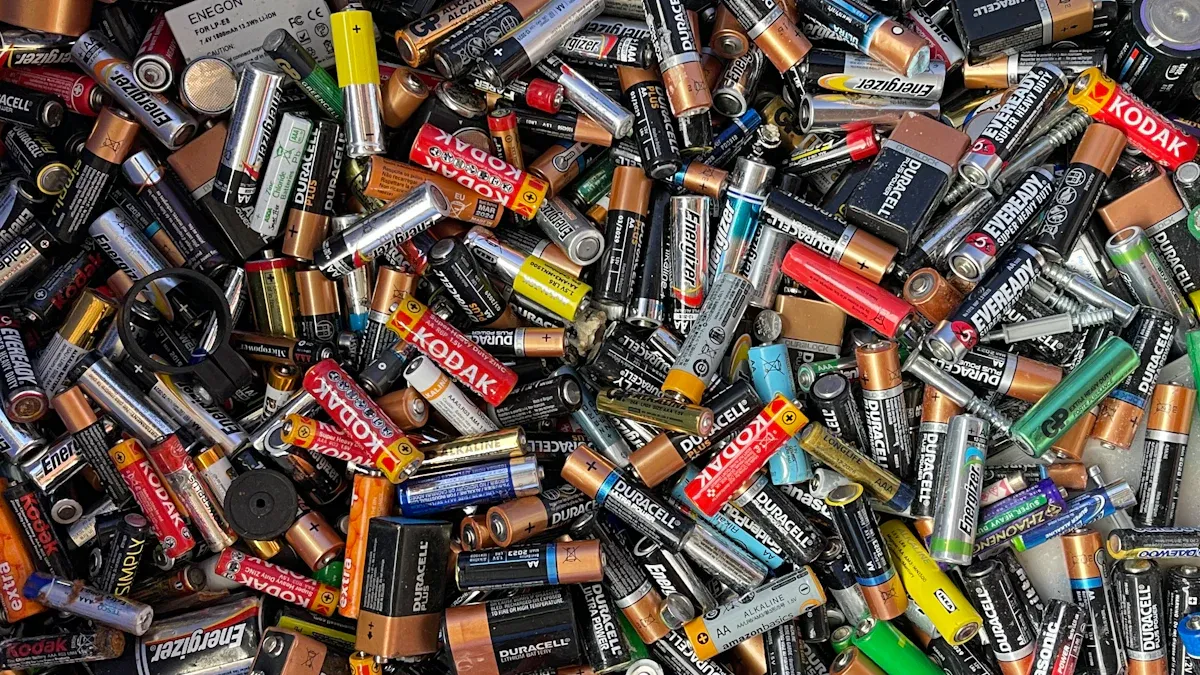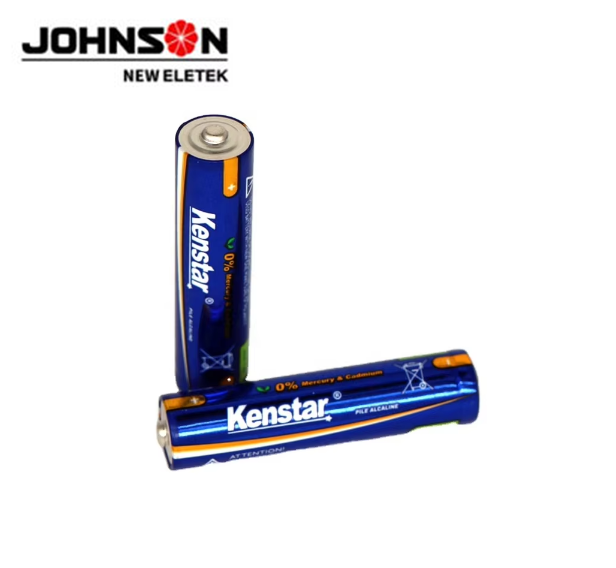When I compare alkaline batteries to regular zinc-carbon options, I notice major differences in how they perform and last. Alkaline battery sales account for 60% of the consumer market in 2025, while regular batteries hold 30%. Asia Pacific leads global growth, pushing the market size to $9.1 billion. 
In summary, alkaline batteries deliver longer life and consistent power, making them ideal for high-drain devices, while regular batteries suit low-drain needs and offer affordability.
Key Takeaways
- Alkaline batteries last longer and provide steady power, making them ideal for high-drain devices like cameras and gaming controllers.
- Regular zinc-carbon batteries cost less and work well in low-drain devices such as remote controls and wall clocks.
- Choosing the right battery type based on device needs and usage saves money and improves performance.
Alkaline Battery vs Regular Battery: Definitions

What Is an Alkaline Battery
When I look at the batteries powering most of my devices, I often see the term “alkaline battery.” According to international standards, an alkaline battery uses an alkaline electrolyte, usually potassium hydroxide. The negative electrode is zinc, and the positive electrode is manganese dioxide. The IEC assigns the code “L” to this battery type. I notice that alkaline batteries deliver a steady voltage of 1.5 volts, which makes them reliable for many electronic devices. The chemical design allows them to last longer and perform better, especially in high-drain gadgets like cameras or toys.
What Is a Regular (Zinc-Carbon) Battery
I also come across regular batteries, known as zinc-carbon batteries. These use an acidic electrolyte, such as ammonium chloride or zinc chloride. Zinc serves as the negative electrode, while manganese dioxide is the positive electrode, just like in alkaline batteries. However, the electrolyte difference changes how the battery performs. Zinc-carbon batteries provide a nominal voltage of 1.5 volts, but their maximum open circuit voltage can reach up to 1.725 volts. I find these batteries work best in low-drain devices, such as remote controls or wall clocks.
| Battery Type | IEC Code | Negative Electrode | Electrolyte | Positive Electrode | Nominal Voltage (V) | Maximum Open Circuit Voltage (V) |
|---|---|---|---|---|---|---|
| Zinc-Carbon Battery | (none) | Zinc | Ammonium chloride or zinc chloride | Manganese dioxide | 1.5 | 1.725 |
| Alkaline Battery | L | Zinc | Potassium hydroxide | Manganese dioxide | 1.5 | 1.65 |
In summary, I see that alkaline batteries use an alkaline electrolyte and offer longer, more consistent power, while regular zinc-carbon batteries use an acidic electrolyte and suit low-drain applications.
Alkaline Battery Chemistry and Construction

Chemical Composition
When I examine the chemical makeup of batteries, I see clear differences between alkaline and regular zinc-carbon types. Regular zinc-carbon batteries use an acidic ammonium chloride or zinc chloride electrolyte. The negative electrode is zinc, and the positive electrode is a carbon rod surrounded by manganese dioxide. In contrast, an alkaline battery uses potassium hydroxide as the electrolyte, which is highly conductive and alkaline. The negative electrode consists of zinc powder, while the positive electrode is manganese dioxide. This chemical setup allows the alkaline battery to deliver higher energy density and a longer shelf life. The chemical reaction inside an alkaline battery can be summarized as Zn + MnO₂ + H₂O → Mn(OH)₂ + ZnO. I notice that the use of potassium hydroxide and zinc granules increases the reaction area, which boosts performance.
How Alkaline and Regular Batteries Work
I often compare the construction of these batteries to understand their performance. The table below highlights the main differences:
| Aspect | Alkaline Battery | Carbon (Zinc-Carbon) Battery |
|---|---|---|
| Negative Electrode | Zinc powder forming the inner core, increasing surface area for reactions | Zinc casing acting as the negative electrode |
| Positive Electrode | Manganese dioxide surrounding the zinc core | Manganese dioxide lining the inner side of the battery |
| Electrolyte | Potassium hydroxide (alkaline), providing higher ionic conductivity | Acidic paste electrolyte (ammonium chloride or zinc chloride) |
| Current Collector | Nickel-plated bronze rod | Carbon rod |
| Separator | Keeps electrodes apart while allowing ion flow | Prevents direct contact between electrodes |
| Design Features | More advanced internal setup, improved sealing to reduce leakage | Simpler design, zinc casing slowly reacts and may corrode |
| Performance Impact | Higher capacity, longer life, better for high-drain devices | Lower ionic conductivity, less steady power, faster wear |
I observe that alkaline batteries use advanced materials and design features, such as zinc granules and improved sealing, which make them more efficient and durable. Regular zinc-carbon batteries have a simpler structure and suit low-power devices. The difference in electrolyte and electrode arrangement leads to alkaline batteries lasting three to seven times longer than regular batteries.
In summary, I find that the chemical composition and construction of alkaline batteries give them a clear advantage in energy density, shelf life, and suitability for high-drain devices. Regular batteries remain a practical choice for low-drain applications due to their simple design.
Alkaline Battery Performance and Lifespan
Power Output and Consistency
When I test batteries in my devices, I notice that power output and consistency make a big difference in performance. Alkaline batteries deliver steady voltage throughout their use. This means my digital camera or gaming controller works at full strength until the battery is nearly empty. In contrast, regular zinc-carbon batteries lose voltage quickly, especially when I use them in high-drain devices. I see the flashlight dim or the toy slow down much sooner.
Here is a table that highlights the main differences in power output and consistency:
| Aspect | Alkaline Batteries | Zinc-Carbon Batteries |
|---|---|---|
| Voltage Consistency | Maintains steady voltage throughout discharge | Voltage drops rapidly under heavy load |
| Energy Capacity | Higher energy density, longer-lasting power | Lower energy density, shorter runtime |
| Suitability for High-Drain | Ideal for devices needing continuous high power | Struggles under heavy load |
| Typical Devices | Digital cameras, gaming consoles, CD players | Suitable for low-drain or short-term use |
| Leakage and Shelf Life | Lower leakage risk, longer shelf life | Higher leakage risk, shorter shelf life |
| Performance in Heavy Load | Provides consistent power, reliable performance | Less reliable, quick voltage drop |
I find that alkaline batteries can provide up to five times more energy than zinc-carbon batteries. This makes them the best choice for devices that need steady, reliable power. I also see that alkaline batteries have a higher energy density, ranging from 45 to 120 Wh/kg, compared to 55 to 75 Wh/kg for zinc-carbon batteries. This higher energy density means I get more use out of each battery.
When I want my devices to run smoothly and last longer, I always choose alkaline batteries for their consistent power and superior performance.
Key Points:
- Alkaline batteries maintain steady voltage and deliver higher energy density.
- They perform better in high-drain devices and last longer under heavy use.
- Zinc-carbon batteries lose voltage quickly and suit low-drain devices.
Shelf Life and Usage Duration
Shelf life and usage duration matter to me when I buy batteries in bulk or store them for emergencies. Alkaline batteries have a much longer shelf life than zinc-carbon batteries. According to recent studies, alkaline batteries can last up to 8 years in storage, while zinc-carbon batteries last only 1 to 2 years. I always check the expiration date, but I trust alkaline batteries to stay fresh much longer.
| Battery Type | Average Shelf Life |
|---|---|
| Alkaline | Up to 8 years |
| Carbon Zinc | 1-2 years |
When I use batteries in common household devices, I see that alkaline batteries last significantly longer. For example, my flashlight or wireless mouse runs for weeks or months on a single alkaline battery. In contrast, zinc-carbon batteries deplete much faster, especially in devices that need more power.
| Aspect | Alkaline Batteries | Zinc-Carbon Batteries |
|---|---|---|
| Energy Density | 4 to 5 times higher than zinc-carbon batteries | Lower energy density |
| Usage Duration | Significantly longer, especially in high-drain devices | Shorter lifespan, depletes faster in high-drain devices |
| Device Suitability | Best for high-drain devices requiring steady voltage output and high current discharge | Suitable for low-drain devices like TV remotes, wall clocks |
| Voltage Output | Maintains steady voltage throughout discharge | Voltage gradually drops during use |
| Degradation Rate | Slower degradation, longer shelf life | Faster degradation, shorter shelf life |
| Temperature Tolerance | Performs reliably across a wider temperature range | Reduced efficiency in extreme temperatures |
I notice that alkaline batteries also perform better in extreme temperatures. This reliability gives me peace of mind when I use them in outdoor equipment or emergency kits.
For long-term storage and longer usage in my devices, I always rely on alkaline batteries.
Key Points:
- Alkaline batteries offer a shelf life of up to 8 years, much longer than zinc-carbon batteries.
- They provide longer usage duration, especially in high-drain and frequently used devices.
- Alkaline batteries perform well in a wide range of temperatures and degrade more slowly.
Alkaline Battery Cost Comparison
Price Differences
When I shop for batteries, I always notice the price difference between alkaline and regular zinc-carbon options. The cost varies by size and packaging, but the trend remains clear: zinc-carbon batteries are more affordable upfront. For example, I often find AA or AAA zinc-carbon batteries priced between $0.20 and $0.50 each. Larger sizes like C or D cost a bit more, usually $0.50 to $1.00 per battery. If I buy in bulk, I can save even more, sometimes getting a 20-30% discount on the per-unit price.
Here’s a table that summarizes the typical retail prices in 2025:
| Battery Type | Size | Retail Price Range (2025) | Notes on Pricing and Use Case |
|---|---|---|---|
| Zinc Carbon (Regular) | AA, AAA | $0.20 – $0.50 | Affordable, suitable for low-drain devices |
| Zinc Carbon (Regular) | C, D | $0.50 – $1.00 | Slightly higher price for larger sizes |
| Zinc Carbon (Regular) | 9V | $1.00 – $2.00 | Used in specialized devices like smoke detectors |
| Zinc Carbon (Regular) | Bulk Purchase | 20-30% discount | Bulk buying reduces per-unit cost significantly |
| Alkaline | Various | Not explicitly listed | Longer shelf life, preferred for emergency devices |
I have seen that alkaline batteries usually cost more per unit. For instance, a typical AA alkaline battery might cost around $0.80, while a pack of eight can reach nearly $10 at some retailers. Prices have increased over the past five years, especially for alkaline batteries. I remember when I could buy a pack for much less, but now even discount brands have raised their prices. In some markets, like Singapore, I can still find alkaline batteries for about $0.30 each, but in the US, prices are much higher. Bulk packs at warehouse stores offer better deals, but the overall trend shows a steady price increase for alkaline batteries.
Key Points:
- Zinc-carbon batteries remain the most affordable choice for low-drain devices.
- Alkaline batteries cost more upfront, with prices rising in recent years.
- Bulk purchases can lower the per-unit cost for both types.
Value for Money
When I consider value for money, I look beyond the sticker price. I want to know how long each battery will last in my devices and how much I pay for each hour of use. In my experience, alkaline batteries deliver more consistent performance and last much longer, especially in high-drain devices like digital cameras or game controllers.
Let me break down the cost per hour of use:
| Feature | Alkaline Battery | Carbon-Zinc Battery |
|---|---|---|
| Cost per Unit (AA) | $0.80 | $0.50 |
| Capacity (mAh, AA) | ~1,800 | ~800 |
| Runtime in High-Drain Device | 6 hours | 2 hours |
Although I pay about 40% less for a zinc-carbon battery, I get only a third of the runtime in demanding devices. This means the cost per hour of use is actually lower for an alkaline battery. I find that I replace zinc-carbon batteries more often, which adds up over time.
Consumer tests back up my experience. Some zinc chloride batteries can outperform alkaline batteries in specific cases, but most zinc-carbon options do not last as long or provide the same value. Not all alkaline batteries are created equal, though. Some brands offer better performance and value than others. I always check reviews and test results before making a purchase.
Post time: Aug-12-2025




